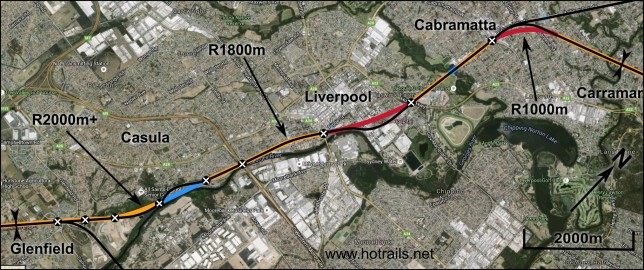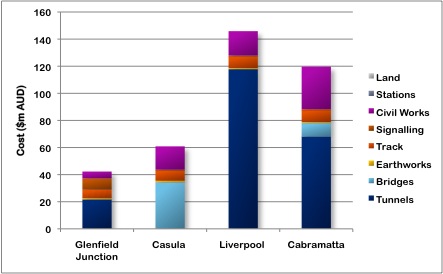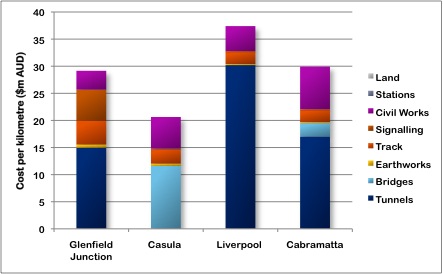← Glenfield Previous | Next Metro Sydney →
In our look at the possible corridors we could use to access inner Sydney, we identified two possible contenders that could get us to within about 15km of Central Station before we had to go underground. The first was to use the East Hills corridor until Revesby or soon after, and subsequently using a long tunnel (15-17km) to Central. The other main option was to use the Cumberland and Inner West corridors via Liverpool and Cabramatta to access the Chullora Railyards, which could get us as close as 12km to Central before we had to go underground. The Liverpool option is slightly superior in terms of length in tunnel, but suffers the disadvantage of greater difficulty in converting the existing corridors to high-speed use. However the Liverpool option has one huge advantage that gives it the edge over the East Hills option, namely that the 12km tunnel could be co-utilised by other fast-rail services such as a “Western Fastrail”-style service to Parramatta and Penrith, or also a northern extension of the high-speed route via Hornsby. None of these options would be practical for a southerly East Hills tunnel. Therefore we are effectively getting three tunnels in one – it can serve as the beginning of fast train services to all three major peripheral regions of Sydney (north, west and southwest).
Alignment design
The existing corridor is mostly straight enough, and can be widened to accommodate a further two tracks without too much difficulty. There are four main challenge areas: 1 – the complicated trackplan at Glenfield Junction, 2 – the deviation at Casula, 3 – the deviation at Liverpool, and 4 – the approach to Cabramatta Junction. These are dealt with variously by duplication of existing flyovers, construction of viaducts, and some sections of tunnel as detailed in the individual sections below.
Glenfield Junction
We start off in a tunnel underneath Glenfield Station so that the existing metro services can continue to use the recently-redeveloped station as they previously have. We’re going to have to stay in the tunnel for some distance until there is room in the corridor to accommodate two extra tracks. The new tracks, like in the previous sector, will be for the existing Cumberland Line tracks, as the central through-tracks are reserved for the high-speed line due to their straightness. This is first possible about 350m in, after the first turnouts to the north of the station. We will then allow another 250m for a ramp-trench, the same as the one specified on entry to Glenfield.
The difficult bit is designing the tracks for the existing Cumberland line. One possibility is to remove the at-grade eastbound line of the East Hills Line (made redundant by the SWRL north flyover) and use the freed-up space for a new set of dual tracks. A duplication of the SWRL flyover would allow the Cumberland Line to proceed adjacent the existing tracks, rejoining the existing alignment at the Casula Deviation. It should be noted that there is a fairly rapid change of grade at the end of this section, from a 1.25% decline to a 1.25% incline. This change of grade (2.5%) is achieved within 750m, which is comfortably within the Hot Rails typical limit for vertical curves.

Trackplan north of Glenfield. Base image: Google Maps
Casula deviation
At Casula Station the existing track has a double reverse-curve of approximate radius 500m, without adequate transition lengths. The high-speed track will depart the existing tracks north of the South Sydney Freight Line flyover, allowing the suburban tracks to rejoin the existing alignment. The high-speed alignment bypasses Casula Station and the associated curves, replacing it with a single curve of radius 2000m or greater. This deviation will be mostly on viaduct, and allows the high-speed line to pass close to the Casula Powerhouse with minimal disruption to the existing infrastructure in this area.

Looking southeast from Casula Green over the existing railway. The high-speed alignment would run on viaduct behind the Powerhouse toward the bottom-left. Image: Wikipedia
Liverpool deviation
The approach to Liverpool Station is characterised by a narrow corridor with dense development to the west and the Georges River to the east; there is just barely enough room in the existing corridor for two extra tracks, but it will require noise attenuation walls along the entire western perimeter due to the closeness to existing houses. At Liverpool itself, the existing track undergoes a reverse curve of minimum radius 500m, and the only practical way to improve this geometry is a tunnel due to the density of surrounding development. There is sufficient room for a ramp trench adjacent the existing stabling yards. A new track is built to the west, while one of the two sidings would be used by the suburban lines. Liverpool is the terminal station for the Bankstown Line, and therefore an extra siding must be built to maintain stabling and turnaround capability.
The tunnel continues under Liverpool Hospital, then the Liverpool Girls High School playing fields and Hart Park, where the cheaper “cut and cover” method of tunneling could be used. The tunnel would surface and rejoin the rail corridor at Warwick Farm north of the Hume Highway.

Trackplan south of Liverpool Station. Base image: Google Maps
Alternatively, Liverpool Station could be rebuilt with new platforms and tracks on the eastern side, and the existing platforms being closed for high-speed through-tracks. The ramp trench for the tunnel could then be built north of the station, potentially saving about 300m of tunnel ($20-30 million). It is unlikely that a major redevelopment of Liverpool Station could be undertaken for less than this amount, so the slightly longer tunnel is the favoured option.
Cabramatta
The existing curve at Cabramatta Junction is about 800m in radius; if we were to build a viaduct so that the HSR line could use the entire width of the corridor, we could just achieve a radius of 1000m. This viaduct (about 1km in length) would cost about 30 million dollars on its own (probably far more due to the difficulty of building over existing tracks and structures). Also consider that it would require the total demolition and rebuild of Cabramatta Station (probably $50-$100 million), noise attenuation walls because it is in a residential area (another $10-$20m), and suddenly a hundred-million dollar tunnel isn’t looking too bad.
There are two ways we could do the tunnel. Either we keep it limited to 200km/h, in which case we have a 1km radius tunnel that’s going to end up about 1100m long and cost about $68 million, or a 1.8km radius tunnel that’s going to be probably twice as long and cost $136m. All the larger-radius tunnel gets us is the ability to go 200km/h with TGV-style trains, or 250km/h with tilting trains. Given the tunnels are specced to 200km/h anyway (it’s a matter of cross-sectional area required for aerodynamics), this isn’t actually necessary. 200km/h is more than sufficient to revolutionise city egress times, and has been adopted as sufficient in the BZE high-speed rail report. So for a saving of $70 million, we will go for the shorter 1km-radius tunnel.
As well as the tunnel, there is a challenge to build an extra two tracks within a corridor which already contains two suburban tracks and a freight line. Given the constraints to corridor width, this will require a retaining wall wherever embankments or cuttings are needed. Additionally, it will probably be necessary to install noise-attenuation walls due to adjacent residential developments.
Summary
The total sector cost is $373.0 million over 12.3km, averaging out to $30.32m/km. This is almost triple the regional average, but that’s to be expected given the urban location. Most of the cost is due to the three tunnels at Glenfield, Liverpool and Cabramatta, which together add up to $207m. Of the remainder, the Casula Viaduct is the single largest cost at $34m, and the requirement for noise-attenuation walls and retaining walls in the narrow suburban rail corridor results in a much higher than normal civil infrastructure cost.
Nevertheless, however expensive this sector is, it’s a hell of a lot cheaper than 12.3km of tunnel. A 12.3km single-bore-dual-track tunnel specified for 200km/h would cost over $760 million on its own, while the government study’s preferred dual-bore tunnels specified for 400km/h would come in at over $1.8 billion. Staying above ground as long as possible pays off very quickly.







